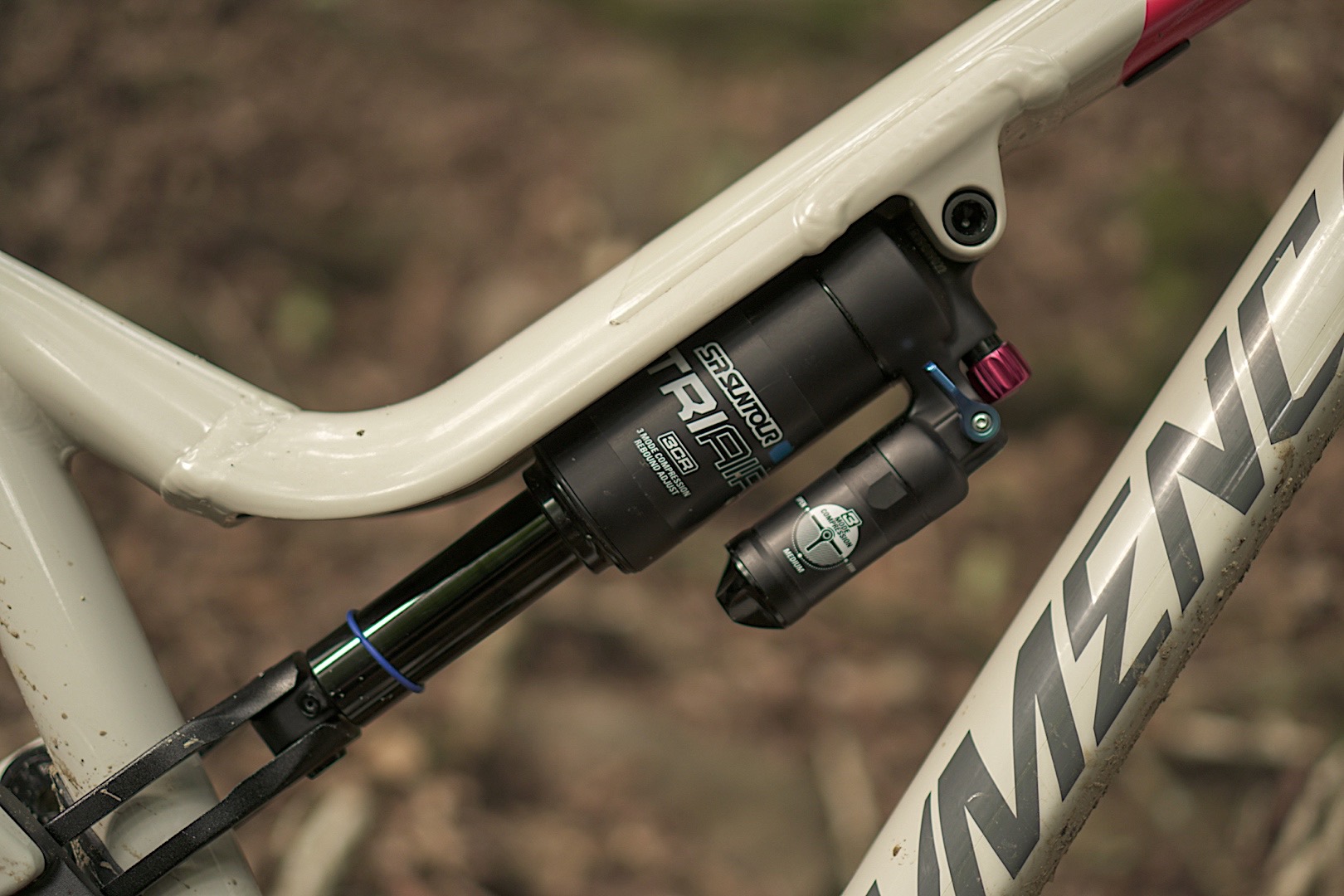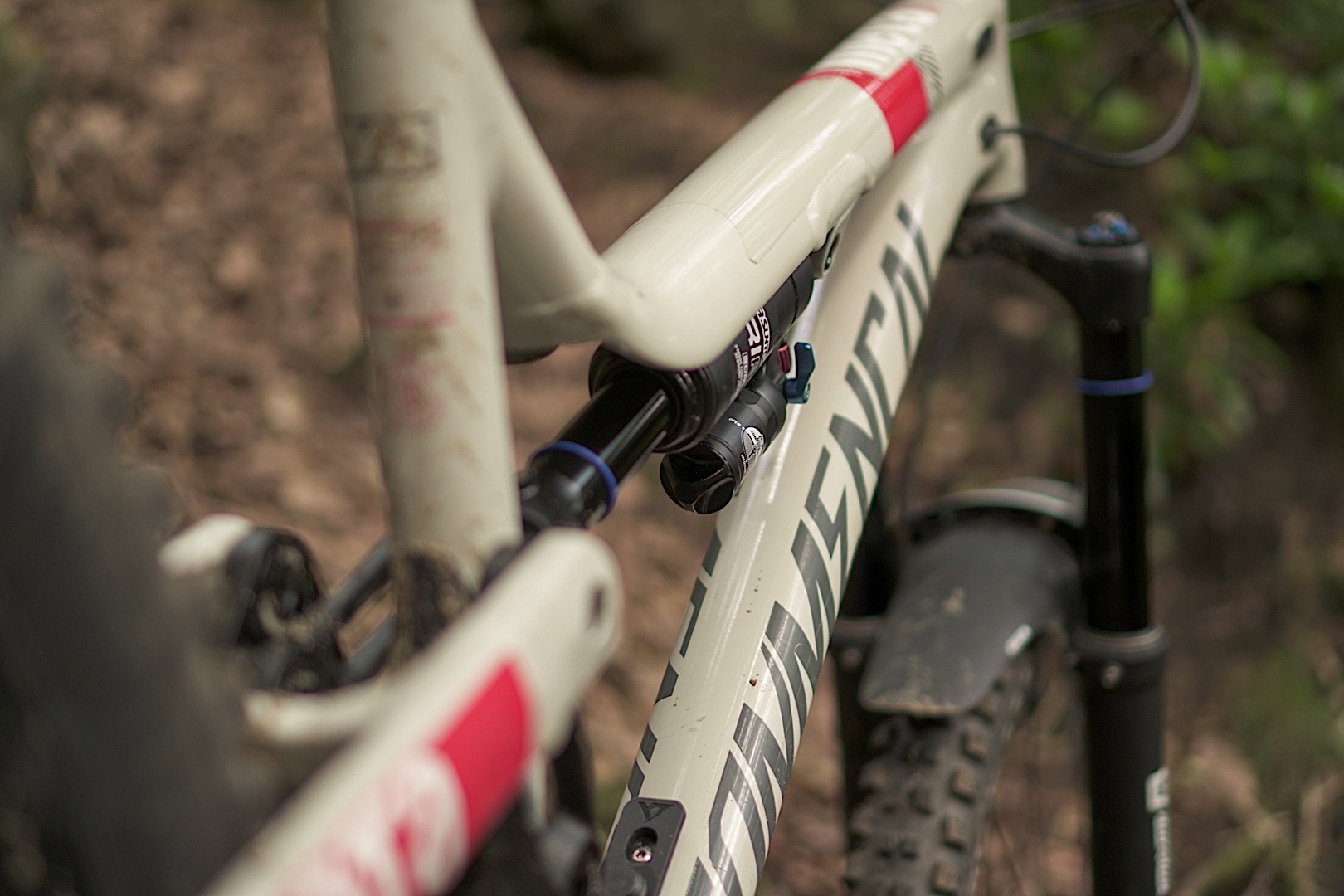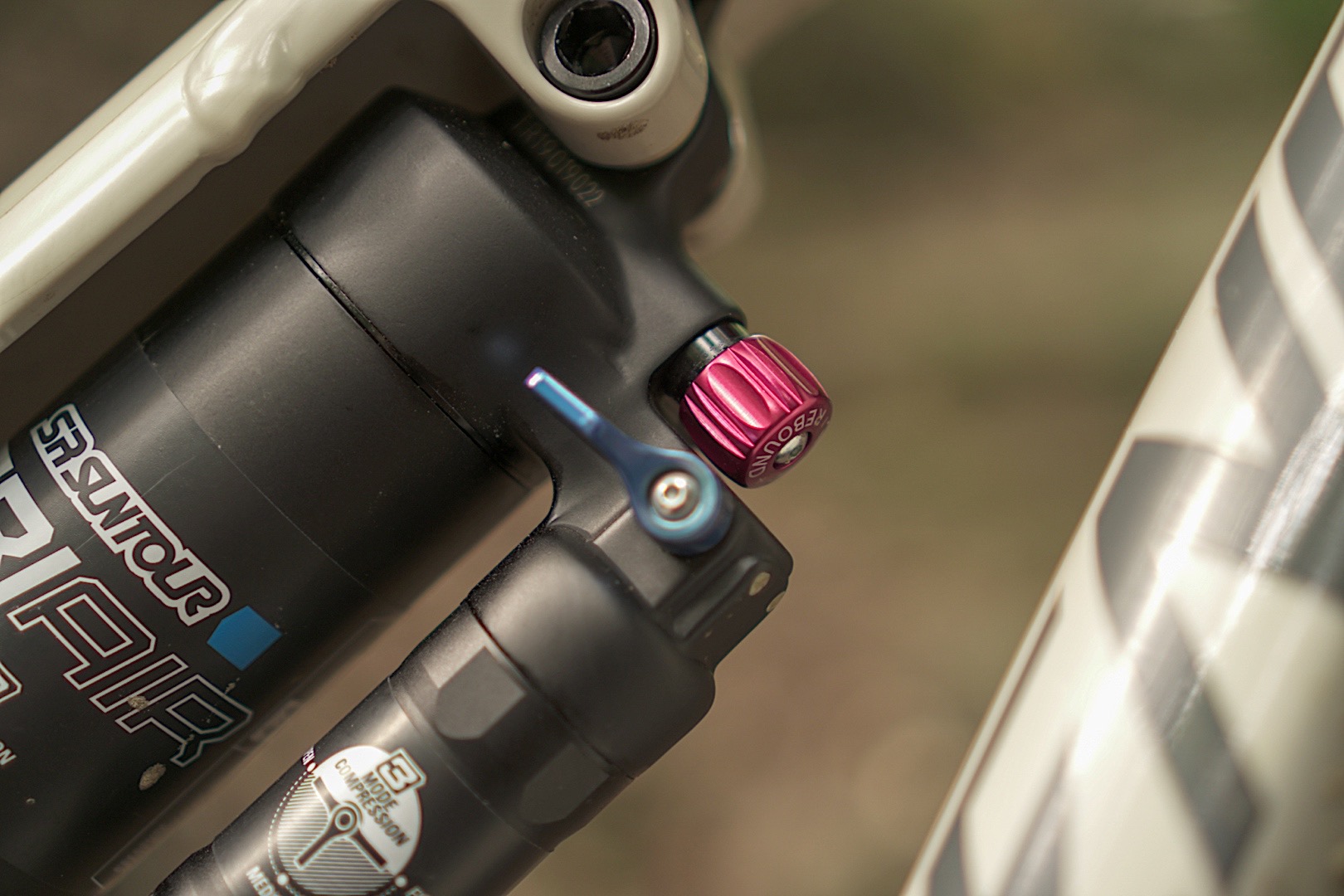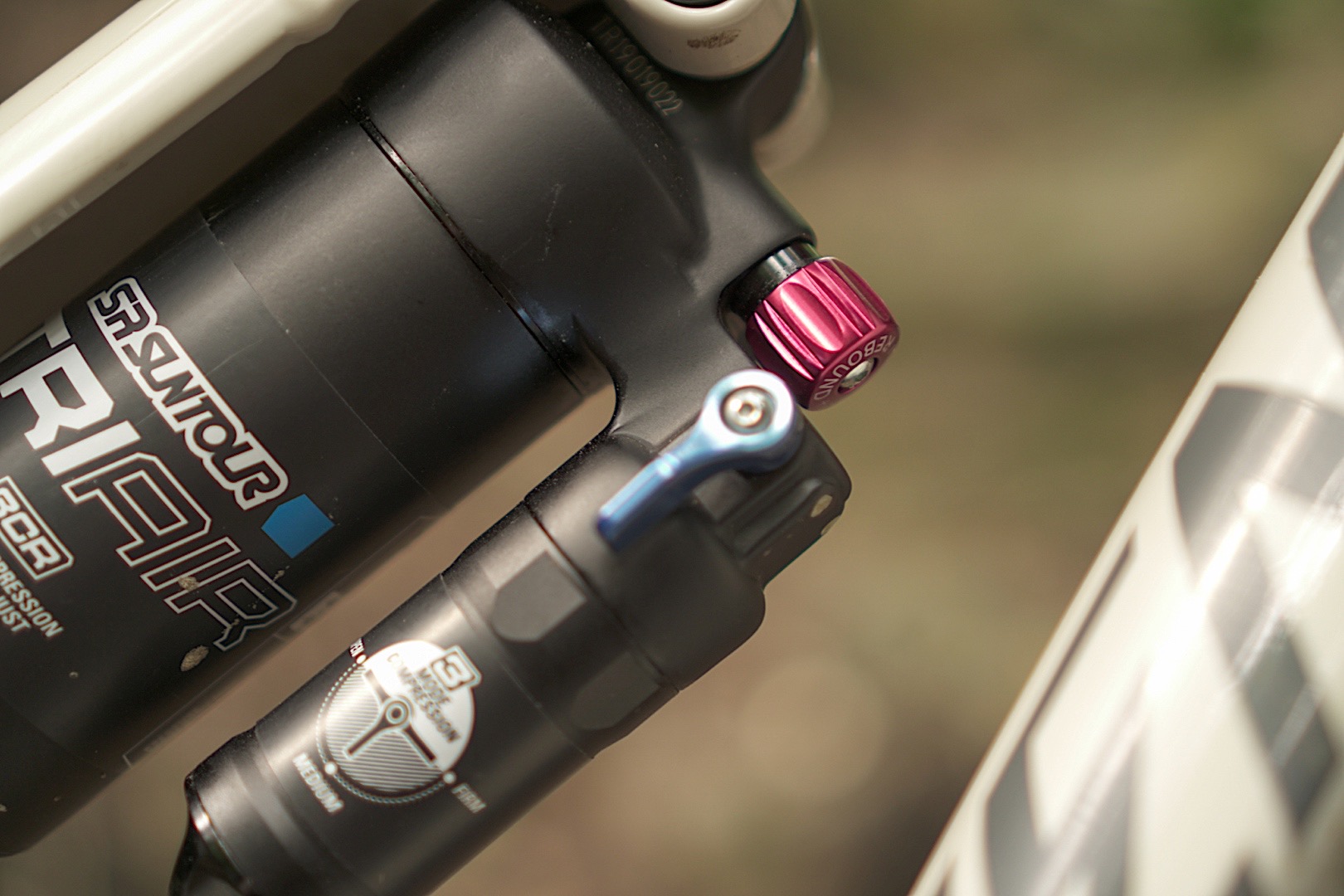The Suntour TriAir 3CR is an affordable rear shock that promises performance and easy maintenance. So, does it live up to the promise?
Perhaps one of the most overlooked parts on many bikes, at least when it comes to upgrades, is the rear shock. We’re all keen to buy new forks, drivetrains, brakes and tyres, but more often than not, rear shocks tend to remain stock.
It’s probably because most stock rear shocks are really very good, and perhaps the fact that a fancy shock upgrade can cost some serious coin, but what if there was a shock that offered a marked performance benefit at a good price?

This is where Suntour comes in. Long known for building the type of suspension you find on supermarket bikes, Suntour is unsurprisingly a large manufacturer and produces forks and shocks for costlier brands. Over the past few years, the company has dedicated a lot of development time to produce its own brand, high-performance kit.
Not convinced? Well just take a look at Downhill World Cup riders Tracy Hannah, Mick Hannah, Alex Marin and Jack Reading to see just how fast, a Suntour equipped bike can be piloted.
Suntour TriAir 3CR Rear Shock
The TriAir 3CR is an air shock design with a piggyback and a couple of external adjustments. A large red knob handles rebound speed while a three-position lever allows fast adjustment of the compression from open, to middle (50% compression) and firm (80% compression).
Compared to high-end shocks from other makers, those adjustments might seem a little basic, but there’s a lot more to play around with on the TriAir than meets the eye.
Obviously, there is the air pressure in the main shock body, but on top of that, you can also open the body and add volume spacers to either the positive or negative air springs. And then for an extra level of fine-tuning and tinkering the IFP (internal floating piston) located on the piggyback can be charged with air separately of the main air spring.
As you can see it’s all fairly simple, and this is a deliberate aim in the design of all of Suntour’s products to make them quick and easy to disassemble and service without the need of specialist tools. Suntour likes to call this QSP or Quick Service Product, and this is the reason behind the use of an IFP rather than a bladder and an easily replaceable damper cartridge, PCS, too.
The PCS, or Piston Compensator System houses the IFP and is designed to not only be a quick service item but also help to minimise cavitation by separating air and oil and reducing the chances of bubbles and pressure being created in the damper circuit. Suntour claims that PCS units have been tested at damping cycles of up to 200,000 so it’s a safe bet that longevity shouldn’t be an issue.
Suntour produces the shock in most popular sizes and the bike is designed for trail/enduro style bikes. For this test we received a 230 x 60mm shock and fitted it to a 2018 Commencal Meta AM 29 with 160mm of rear wheel travel.
Suntour TriAir 3CR on the trail
Bolting the TriAir onto my Meta AM was a breeze, but just like the shock it was replacing, the piggyback doesn’t leave much room for a full-sized bottle (unless you happen to have one of those custom YT bottles) but this is more a comment on the frame than the shock. That said the compression lever is quite long and might have clearance issues on some frames when flicked into the firm mode.

Once fitted and with the sag set to 25% the first thing that struck me was how supple the TriAir 3CR is off the top. On other air shocks, there is a certain amount of force needed to break past the seal stiction and get the rear shock moving, but the Suntour shock is much easier to get moving.
Then there is the noticable mid-stroke support which the IFP in the piggyback adds. While the initial stroke is supple, the shock sits nicely mid-stroke preventing the bike from wallowing under load, and sprinting.
In fact, the TriAir 3CR is much more linear than most air shocks, especially noticeable when running zero volume spacers, which does give it the most coil-like feel I have experienced from an air shock. Adding spacers makes a marked increase in progression and a combination of volume spacers and IFP can be used to get the feel just how you like and with the amount of platform that you’re after.
On the trail, the TriAir performs extremely well and the level of grip is an impressive step above the RockShox Super Deluxe which it took over from. The rear wheel feels much more planted and there’s less breakaway on loose corners due to the impressive small bump and chatter performance.

As trail speeds increase, rocks get larger and drops deeper, the TriAir never struggled to keep up, retaining its impeccable grip and traction while ramping up enough to shrug off square-edge hits and retain an engaging and lively ride.
There is one section of a local trail that has a fast entry and braking bumps before a flat corner. If you don’t get your timing right you’ll hit the bumps too fast and lose your footing on the pedals, at least I did with the RockShox shock originally fitted to the bike. With the TriAir fitted I was able to hit this section much faster and keep my feet firmly in place.
The three step compression lever is a neat adjustment for quickly switching from fully open, for natural rocky trails, to the middle setting with 50% compression for smoother flow trails. Of course, the three positions on the lever won’t match the infinite adjustments found on a high-end Fox, EXT or Öhlins shocks, but for the rider who wants performance and simplicity, it’s a good compromise and one that works very well.
What could be better
- Compression lever is quite large and might have clearance issues on some frames.
- The ‘clicks’ on the rebound aren’t easy to register.
- I had to run the rebound nearly at the fastest setting, but this is something Suntour can adjust.
What we loved
- Simple design with a ton of great features.
- Excellent value for money.
- Extremely supple off the top.
Conclusion

The retail price on the SR Suntour website is just £333.65, and at the time of writing there is 15% off all shocks and forks making it just £283.60. If you shop around you can find the shock for just €250 on some online stores (depending on shock length and stroke) and for that price I can’t think of another upgrade that will make your bike faster and more comfortable.
No, it isn’t as refined or adjustable as a Fox shock, but it’s a fraction of the price, and for my riding style it handles the bumps way better than an equivalent RockShox shock. If it was my money the TriAir 3CR is where I would spend it.










Nice review. I’m running a Fox Float X on my v2 Bronson. It doesn’t have much more in the way of adjustability and I like the idea of an adjustable IFP. Currently, I’ve got the Fox rammed full of tokens to get the progression I need. Do you think the Suntour might let me get a more progressive feel?
Another superb feature on this thing is: the travel spacers are clipped, so no need to die-assemble the shock to change the Travel on the metric shock. Woeks so good on my Pyga Hyrax, which can be set from 140mm to 160mm in no time
I got one a week ago, just mounted it to my Orbea Rallón R4. Haven’t had the chance to properly test it, but so far with a couple of rides around the block I’m pretty amazed with how little effort it takes to get this shock moving. From what I’ve gathered online I should add a spacer to the negative chamber or up the pressure in the piggyback 20-30 PSI from the stock one (200 PSI from factory).
This review is spot on, and it should also help me to better tune the shock once the restrictions get a little bit relaxed and I’m able to return to the trails.
@slimshady it’s a great shock. I believe I’m running the IFP at 230psi at the moment if that helps.
“IFP can be used to get the feel just how you like and with the amount of platform that you’re after.”
How does adjusting the IFP pressure affect the ‘platform’ (damping curve), unless it has a pressure / position sensitive valve (like SPV)? I doubt it does since Suntour make no mention of anything like that.
@Andi, finally gave a proper beating to the shock this morning. Thanks so much for the IFP tip! I was running the factory set pressure (200 psi IIRC) and upping it to 220 gave me the support I was seeking this shock.
Also, the rebound could certainly be a lot faster before it feels uncontrolled. Too bad I don’t have a Suntour service center anywhere near here in Argentina. But then again, it’s a helluva shock for 220 Euros. I guess I’ll play with the volume adjust once I’m bound for more gravity focused rides. The stock, no-spacers setup works pretty well in my bike and my home trails.
Just fitted this shock on a Stage 6 today thanks to this review. Either the original Monarch Plus was a complete duffer, or this is a huge upgrade. Either way, a few laps of the Pleney in Morzine at lunch and I’m blown away 🙂 Looking forward to taking it on a trail ride soon. Thanks!